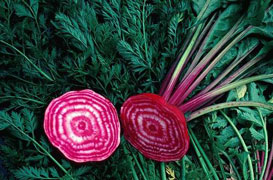


Home
Flowers &
Indoor Plants
Fruits & Nuts
Ornamentals
Vegetables
Special Topics
Resources
Glossary

Beets |
 |
What about lt? Beets are in the same family as spinach, and lambsquarter. Beets and Swiss chard are the same species but different varieties. Beets are typically red but there is a golden yellow variety. They are a fast growing vegetable, and it is possible to harvest them twice in a season. What is it used for? Beets are grown for the large, edible storage root. However, the leaves can be eaten and are actually a great source of vitamins A and C, B1, B2, calcium and iron. Where does it grow? How do we grow it? Beets require about 60 days from planting to harvest They will perform best in cool, moist climates. To achieve a good harvest you will need to "thin" your beets. This means removing some of the small plants so that the remaining ones have enough room to grow. If you fail to thin, the beets will remain small and underdeveloped at harvest time. Beets need about 2-3 inches of growing space around them One beet seed is actually a dried fruit that contains several seeds within it. So, even if you swear that you had planted the seeds a good distance apart and your beet patch still needs thinning, it's a good sign that all of your seeds have sprouted and you are planting in healthy, productive soil. What are its primary problems? Beets tend to have the most problems with leafminers that mine between the leaf surfaces. Leathoppers and wireworms can also be pests. How do we propagate it? Beets are propagated by seeds. Plant the seed 1/2 inch deep and one inch apart. How do we harvest and store it? Beet taste and texture peaks when the beets are at golf ball size. It is best to dig beets out of the ground with a trowel rather than attempting to pull them out by hand. The latter form of harvesting tends to break off the narrow taproot at the base of the round storage root. This exposes the plant to diseases and quick decay. If the leaves are healthy, they can be left on the plant for a short time or eaten. If you are storing the beets, be sure to remove the leaves because they will draw water out from the root. When cutting, trim the leaf stalks evenly about 1 inch from the root. Do not trim the taproot. After harvesting, do not expose beets to the sun. They should be stored in a cooled or refrigerated space to prevent water loss.
© Copyright, Department of Horticulture, Cornell University. |